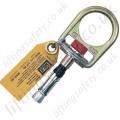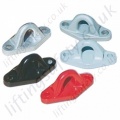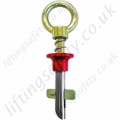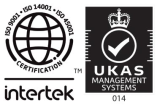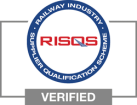-
Lifting Equipment
 Browse Lifting Equipment Shop
Browse Lifting Equipment Shop
- Chain Hoists
-
Wire Rope Hoists
- Hand Operated Wire Rope Winches and Hoists
- Cable Pullers / Hoists, Wire Rope Manual Operation
- Electric Winches and Hoists, AC (Mains Powered)
- Scaffold Hoists & Accessories
- Overhead Wire Rope Crane Hoists
- Hydraulic Wire Rope Winches & Hoists
- Pneumatic Wire Rope Air Winches / Hoists (Lifting and Pulling)
- Vehicle Mounted Winches
- Tractel Wire Rope & Accessories
-
General Lifting Equipment
- Fibre Slings
- Chain Slings Assemblies & Components
- Lifting and Lashing Chain
- Wire Rope Slings & Assemblies
- Shackles
- Eyebolts and Eyenuts
- Lifting & Pulling Clamps
- Lifting Beams & Spreader Beams
- Precast Concrete Lifting
- Lifting Magnets, Permanent, Battery Electric and Manual
- Runway Beam Monorail Crane Trolleys, Push, Geared & Electric
- Equipment Identification Tags
-
Rigging Equipment
- Crosby Lifting & Rigging
- Master Ring & Load Suspension Eyes
- Lifting & Rigging Hooks
- Turnbuckles & Rigging Screws
- Wire Rope Accessories and Fittings
- Snatch Blocks, Sheave Blocks and Crane Pulley Blocks
- Load Restraint Equipment
- General Rigging Accessories
- Lifting & Rigging Swivels - Eye, Hook & Shackle
- Pulley Sheaves
-
Cranes & Gantry Systems
- Portable Davit Arms and Jib Cranes
- Swing Jib Cranes - Installed Floor & Wall Cranes
- Portable/Mobile Free-standing Swing Jib Cranes
- Aluminium Gantries
- Steel Gantries
- Fixed Steel Gantry Systems
- Shearlegs, Tripods & Quadpods
- Overhead Crane Systems
- Portable Shop-Floor/Workshop/Garage Cranes
- Counterbalance Floor, Workshop Cranes
- Scaffolding Runway Beam Systems
-
Material Handling & Jacking Equipment
- Machinery & Load Moving Skates
- Hydraulic Cylinders & Pumps
- Lifting Jacks
- Manhole Cover Lifters
- Hydraulic Pull Cylinders
- Hand Operated Pallet Trucks, Pump Trucks
- Stacker Trucks, Materials Lifts, Manual and Electric
- Genie and Counterbalance Materials Lifters
- Scissor Lift Tables
- Drum Handling Equipment
- Crane Forks
- Load Weighing Equipment - Load Cells
- Tool Spring Balancers / Load Balancers
- Platform Trucks & Trolleys
-
Fork Lift Truck Attachments
- Fork Mounted Man Riding Baskets
- Environment & Waste Handling Attachments
- Fork Lift Truck Mounted Drum Handling Attachments
- Fork Mounted Jib and Hook Attachments
- Fork Truck Booms & Tines
- Stainless Steel Forklift Attachments
- Forklift Truck Fork Extensions
- Multi Fork Attachments
- Fork Truck Scoop Attachments
- Big Bag Fork Truck Attachment
- Closed Base Coil Support Attachments
- Forklift Fork Protection Sleeves
- Snow Plough Fork Lift Truck Attachments
- Other Forklift Truck & Telehandler Attachments
- Specialist Lifting Equipment
- Access and Safety Related
- Workshop and Shop Floor
- Screwjacks & Actuators
-
Height Safety
 Browse Height Safety Store
Browse Height Safety Store
-
Fall Arrest and Height Safety Harnesses
- General Use Harnesses EN361
- Work Positioning Harnesses EN361 & EN358
- Rope Access Harnesses
- Rescue Harnesses EN1497 & EN361
- Ladies & Childrens Harnesses
- Hi Vis Jacket/Vest Harnesses
- Welders Harnesses
- ATEX (Anti-Static) Harnesses
- Linesman Harnesses
- Oil Derrick Harnesses
- Sport Climbing Harnesses
- Tree Surgeon Positioning Harnesses
- Sit and Chest Harnesses. EN361 EN356 & EN831
- Work Positioning & Restraint Belts EN358
- Fall Arrest, Restraint and Positioning Lanyards
- Height Safety and Fall Arrest Kits
- Inertia Reels and Retrieval Blocks
- Man-riding Hoists & Rescue Winches
-
Fall Arrest & Man-riding Systems
- Fall Arrest Davit Arms & Posts for Working at Height
- Sala Advanced Davit Arm Systems and Components
- Xtirpa Confined Space Davit Arm Systems and Components
- Abtech Man-riding, Fall Arrest and Rescue Davits and Components
- Man-riding & Rescue Tripods & Quadpods
- Manriding Systems, Baskets and Chairs
- Mobile Fall Arrest Gantries, Systems & Steps
- Rope Guided Fall Arresters (Steel & Synthetic Rope)
- Temporary Horizontal Fall Arrest Lifelines
- Vertical Fall Arrest Systems Permanently Installed
- Horizontal Fall Arrest Systems Permanently Installed
- Manriding Baskets Fork Truck and Overhead Crane
- Tank Side Entry and Vehicle Fall Arrest Systems
- Suspension Seats / Bosuns Chair Working at Height
- Collective Fall Arrest Systems
- Man-Riding Sheave Blocks
- Anchorage Devices
- Karabiners & Connectors
- Rescue, Evacuation & Rope Access
-
General Height Safety Gear
- Height Safety Accessories
- Industrial & Climbing Height Safety Helmets
- Synthetic Height Safety Rope & Anchorage Lines
- Height safety Pulley Wheels For Synthetic & Steel Wire Rope
- Black Height Safety Equipment & PPE
- Hot Work Equipment. Cutting, Grinding & Welding
- Cases, Bags, Backpacks, Holdalls. Height Safety Gear
- Telescopic Extension Pole for Height Safety Applications
- Wind Energy Height Safety Equipment
-
Stainless Steel Fall Arrest Equipment
-
Fall Arrest and Height Safety Harnesses
- Home
- About Us
-
Contact
Get In Touch
- Home/
- Fall Arrest & Height Safety Equipment/
- Fall Arrest Anchorage Devices/
- Fall Arrest Restraint & Rescue Eye Bolts EN795/
- Protecta Fall Arrest and Rescue Points/
- Protecta "AM211" Stainless Steel D-Ring Fall Arrest Anchorage Point, Single Person Only
Protecta "AM211" Stainless Steel D-Ring Fall Arrest Anchorage Point, Single Person Only
EN795 D-Ring Anchorage Point
AM211 / DAP-2969
Manufacturing Standard: EN 795 class B
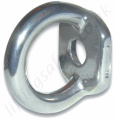
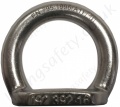

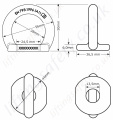
The AM211 Protecta Fixed Anchorage Point is corrosion resistant stainless steel anchor point rated for a single user in two directions. It installs in steel structures with an M12 A2 or A4 class bolt, or in masonry with an M12 chemical resin fastener.
The Fixed Anchorage Point is a single point fall arrest anchor tested to, and in conformance with EN795 Class B. It can serve as the anchorage point(s) for a lanyard. The Fixed Anchorage Point allows the user full freedom in the work zone while securely connected to a safety system. Users should attach to the Fixed Anchorage Point via a energy absorbing lanyard attached to a full body harness.
- Can be used as an anchorage point for Fall Arrest, Positioning, Suspension, and Fall Restraint systems.
- Made from AISI 316 stainless steel.
- Net weight : 110g.
- Conformity with EN 795 class B.
- Dimensions: See 'AM211 Anchorage Point Dimensions' Image above.
Capacity
The maximum number of persons that can be connected to the Fixed Anchorage Point for Fall Arrest purposes is one (1) user.
Applied Loads
The AM211 EN795 Anchorage Point Loading Directions Image below shows correct and incorrect loading directions for the Fixed Anchorage Point.
Loads should always be applied in directions parallel to the anchor faces and never perpendicular to the anchor faces.
The Fixed Anchorage Point is designed for use with systems that limit applied arrest loads to 6 kN or less. Static loads must not exceed 272 kg. Only one person can be attached to the Fixed Anchorage Point. Attachment of two PPE systems by a single user is prohibited.
Installation
Installation of the Fixed Anchorage Point must be performed by competent person(s) familiar with the Fixed Anchorage Point.
Anchorage Structure
The structure to which the Fixed Anchorage Point is mounted must be capable of sustaining 12 kN of force in the anticipated direction(s) of loading (see below). Each Fixed Anchorage Point location must be capable of sustaining this load.
| AM211 EN795 Anchorage Point Loading Directions |
 |
Plane of Anchorage Surface
If the Fixed Anchorage Point is to be installed on a surface that is not perpendicular to the user walking level (e.g., curved or inclined roof, narrow ledge at head height), or a curved surface perpendicular to the user walking level (e.g., silo or vat), consult Capital Safety prior to installation.
Installation Height
The Fixed Anchorage Point may be installed at any practical height above the work surface.
Restraint Systems
Where possible, installations should be designed as a restraint application. Restraint systems prevent the user from reaching a position where a fall can occur; therefore, no free-fall is possible.
Fall Arrest Systems
When the Fixed Anchorage Point is used in a Fall Arrest system, it is important to consider the following factors during design
- Anchorage Point - Mount the anchor as high as possible in relation to the user. This minimizes possible free fall, making rescue easier and less distressing for the victim. Avoid anchor locations that increase the chance of swing fall. Swing falls occur when the anchorage point is not directly above the point where a fall occurs. The force of striking an object in a swing fall may cause serious injury or death. Minimize swing falls by working as close to the anchorage point as possible.
- Anchor Orientation - The Fixed Anchorage Point must be correctly oriented to support the loads applied by the system (see above image).
- Hazards - The work area and path below should be free of any hazards (vehicles, fences, balconies, pedestrians, water/chemicals, etc.) that could injure the user or others if a fall occurs.
Fastening Requirements
- The Fixed Anchorage Point is installed with M12 fasteners:
- Install in metal with an M12 A2 or A4 Class Stainless Steel Bolt.
- Install in masonry with an M12 Adhesive Anchoring System (Hilti HIT-HY 150 or equivalent). Follow the manufacturer’s instructions for installing the Adhesive Anchoring system.
- A Locking Nut and Washer must be used in all installations. All fasteners should be tightened to the fastener manufacturer’s torque recommendations.
- Attach the included Installation Label to the Fixed Anchorage Point after installation.
Proof Load Testing
After installation, the Fixed Anchorage Point must be proof loaded. Using a tension tester, apply a 5kN load for at least 15 seconds in a direction perpendicular to the mating surface. There should be no pull out from the installation structure or deformation of the Fixed Anchorage Point eye.
The AM211 Protecta Fixed Anchorage Point is corrosion resistant stainless steel anchor point rated for a single user in two directions. It installs in steel structures with an M12 A2 or A4 class bolt, or in masonry with an M12 chemical resin fastener.
The Fixed Anchorage Point is a single point fall arrest anchor tested to, and in conformance with EN795 Class B. It can serve as the anchorage point(s) for a lanyard. The Fixed Anchorage Point allows the user full freedom in the work zone while securely connected to a safety system. Users should attach to the Fixed Anchorage Point via a energy absorbing lanyard attached to a full body harness.
- Can be used as an anchorage point for Fall Arrest, Positioning, Suspension, and Fall Restraint systems.
- Made from AISI 316 stainless steel.
- Net weight : 110g.
- Conformity with EN 795 class B.
- Dimensions: See 'AM211 Anchorage Point Dimensions' Image above.
Capacity
The maximum number of persons that can be connected to the Fixed Anchorage Point for Fall Arrest purposes is one (1) user.
Applied Loads
The AM211 EN795 Anchorage Point Loading Directions Image below shows correct and incorrect loading directions for the Fixed Anchorage Point.
Loads should always be applied in directions parallel to the anchor faces and never perpendicular to the anchor faces.
The Fixed Anchorage Point is designed for use with systems that limit applied arrest loads to 6 kN or less. Static loads must not exceed 272 kg. Only one person can be attached to the Fixed Anchorage Point. Attachment of two PPE systems by a single user is prohibited.
Installation
Installation of the Fixed Anchorage Point must be performed by competent person(s) familiar with the Fixed Anchorage Point.
Anchorage Structure
The structure to which the Fixed Anchorage Point is mounted must be capable of sustaining 12 kN of force in the anticipated direction(s) of loading (see below). Each Fixed Anchorage Point location must be capable of sustaining this load.
| AM211 EN795 Anchorage Point Loading Directions |
 |
Plane of Anchorage Surface
If the Fixed Anchorage Point is to be installed on a surface that is not perpendicular to the user walking level (e.g., curved or inclined roof, narrow ledge at head height), or a curved surface perpendicular to the user walking level (e.g., silo or vat), consult Capital Safety prior to installation.
Installation Height
The Fixed Anchorage Point may be installed at any practical height above the work surface.
Restraint Systems
Where possible, installations should be designed as a restraint application. Restraint systems prevent the user from reaching a position where a fall can occur; therefore, no free-fall is possible.
Fall Arrest Systems
When the Fixed Anchorage Point is used in a Fall Arrest system, it is important to consider the following factors during design
- Anchorage Point - Mount the anchor as high as possible in relation to the user. This minimizes possible free fall, making rescue easier and less distressing for the victim. Avoid anchor locations that increase the chance of swing fall. Swing falls occur when the anchorage point is not directly above the point where a fall occurs. The force of striking an object in a swing fall may cause serious injury or death. Minimize swing falls by working as close to the anchorage point as possible.
- Anchor Orientation - The Fixed Anchorage Point must be correctly oriented to support the loads applied by the system (see above image).
- Hazards - The work area and path below should be free of any hazards (vehicles, fences, balconies, pedestrians, water/chemicals, etc.) that could injure the user or others if a fall occurs.
Fastening Requirements
- The Fixed Anchorage Point is installed with M12 fasteners:
- Install in metal with an M12 A2 or A4 Class Stainless Steel Bolt.
- Install in masonry with an M12 Adhesive Anchoring System (Hilti HIT-HY 150 or equivalent). Follow the manufacturer’s instructions for installing the Adhesive Anchoring system.
- A Locking Nut and Washer must be used in all installations. All fasteners should be tightened to the fastener manufacturer’s torque recommendations.
- Attach the included Installation Label to the Fixed Anchorage Point after installation.
Proof Load Testing
After installation, the Fixed Anchorage Point must be proof loaded. Using a tension tester, apply a 5kN load for at least 15 seconds in a direction perpendicular to the mating surface. There should be no pull out from the installation structure or deformation of the Fixed Anchorage Point eye.
Pricing
Products of Possible Interest
Contact Us About This Product
If you wish to receive a quote for this product, please use the 'Pricing' tab above, this form is for general enquiries regarding this product only.
You can also Request a Quote using the Buy/Quote tab above!
You can easily add more than one item to the Quote Request. This is highly recommend as we will be able to suit your needs much more efficiently.
Share this page!

Save this QR code
for use on Smart Phones
